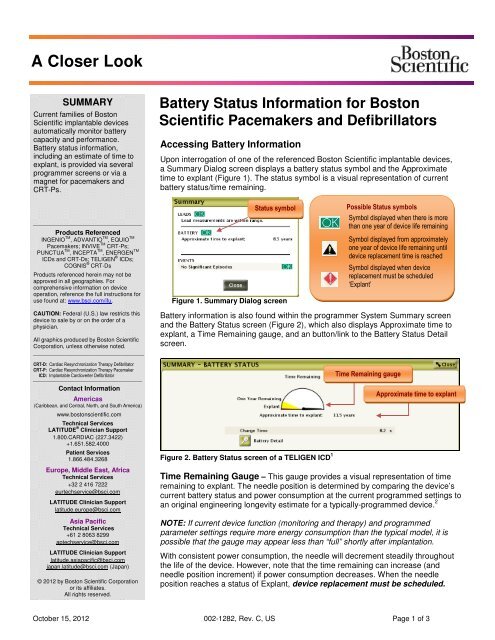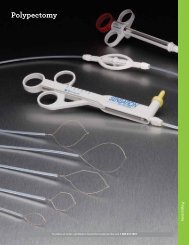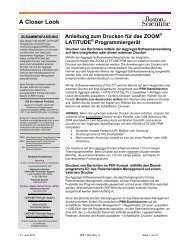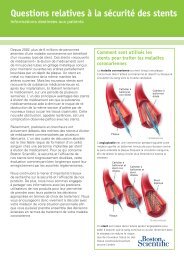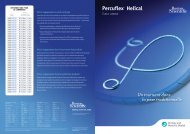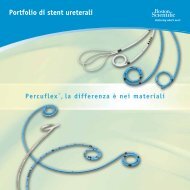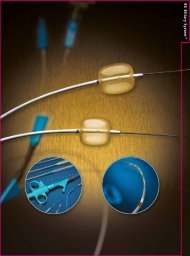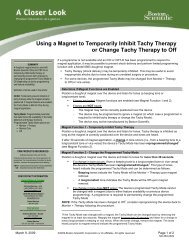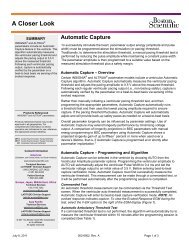A Closer Look Battery Status Information for Boston - Boston Scientific
A Closer Look Battery Status Information for Boston - Boston Scientific
A Closer Look Battery Status Information for Boston - Boston Scientific
You also want an ePaper? Increase the reach of your titles
YUMPU automatically turns print PDFs into web optimized ePapers that Google loves.
A <strong>Closer</strong> <strong>Look</strong><br />
SUMMARY<br />
Current families of <strong>Boston</strong><br />
<strong>Scientific</strong> implantable devices<br />
automatically monitor battery<br />
capacity and per<strong>for</strong>mance.<br />
<strong>Battery</strong> status in<strong>for</strong>mation,<br />
including an estimate of time to<br />
explant, is provided via several<br />
programmer screens or via a<br />
magnet <strong>for</strong> pacemakers and<br />
CRT-Ps.<br />
Products Referenced<br />
INGENIO TM , ADVANTIO TM , EQUIO TM<br />
Pacemakers; INVIVE TM CRT-Ps;<br />
PUNCTUA TM , INCEPTA TM , ENERGEN TM<br />
ICDs and CRT-Ds; TELIGEN ® ICDs;<br />
COGNIS ® CRT-Ds<br />
Products referenced herein may not be<br />
approved in all geographies. For<br />
comprehensive in<strong>for</strong>mation on device<br />
operation, reference the full instructions <strong>for</strong><br />
use found at: www.bsci.com/ifu.<br />
CAUTION: Federal (U.S.) law restricts this<br />
device to sale by or on the order of a<br />
physician.<br />
All graphics produced by <strong>Boston</strong> <strong>Scientific</strong><br />
Corporation, unless otherwise noted.<br />
CRT-D: Cardiac Resynchronization Therapy Defibrillator<br />
CRT-P: Cardiac Resynchronization Therapy Pacemaker<br />
ICD: Implantable Cardioverter Defibrillator<br />
Contact <strong>In<strong>for</strong>mation</strong><br />
Americas<br />
(Caribbean, and Central, North, and South America)<br />
www.bostonscientific.com<br />
Technical Services<br />
LATITUDE ® Clinician Support<br />
1.800.CARDIAC (227.3422)<br />
+1.651.582.4000<br />
Patient Services<br />
1.866.484.3268<br />
Europe, Middle East, Africa<br />
Technical Services<br />
+32 2 416 7222<br />
eurtechservice@bsci.com<br />
LATITUDE Clinician Support<br />
latitude.europe@bsci.com<br />
Asia Pacific<br />
Technical Services<br />
+61 2 8063 8299<br />
aptechservice@bsci.com<br />
LATITUDE Clinician Support<br />
latitude.asiapacific@bsci.com<br />
japan.latitude@bsci.com (Japan)<br />
© 2012 by <strong>Boston</strong> <strong>Scientific</strong> Corporation<br />
or its affiliates.<br />
All rights reserved.<br />
<strong>Battery</strong> <strong>Status</strong> <strong>In<strong>for</strong>mation</strong> <strong>for</strong> <strong>Boston</strong><br />
<strong>Scientific</strong> Pacemakers and Defibrillators<br />
Accessing <strong>Battery</strong> <strong>In<strong>for</strong>mation</strong><br />
Upon interrogation of one of the referenced <strong>Boston</strong> <strong>Scientific</strong> implantable devices,<br />
a Summary Dialog screen displays a battery status symbol and the Approximate<br />
time to explant (Figure 1). The status symbol is a visual representation of current<br />
battery status/time remaining.<br />
<strong>Status</strong> symbol<br />
Figure 1. Summary Dialog screen<br />
<strong>Battery</strong> in<strong>for</strong>mation is also found within the programmer System Summary screen<br />
and the <strong>Battery</strong> <strong>Status</strong> screen (Figure 2), which also displays Approximate time to<br />
explant, a Time Remaining gauge, and an button/link to the <strong>Battery</strong> <strong>Status</strong> Detail<br />
screen.<br />
Figure 2. <strong>Battery</strong> <strong>Status</strong> screen of a TELIGEN ICD 1<br />
Possible <strong>Status</strong> symbols<br />
Symbol displayed when there is more<br />
than one year of device life remaining<br />
Symbol displayed from approximately<br />
one year of device life remaining until<br />
device replacement time is reached<br />
Symbol displayed when device<br />
replacement must be scheduled<br />
‘Explant’<br />
Time Remaining gauge<br />
Approximate time to explant<br />
Time Remaining Gauge – This gauge provides a visual representation of time<br />
remaining to explant. The needle position is determined by comparing the device’s<br />
current battery status and power consumption at the current programmed settings to<br />
an original engineering longevity estimate <strong>for</strong> a typically-programmed device. 2<br />
NOTE: If current device function (monitoring and therapy) and programmed<br />
parameter settings require more energy consumption than the typical model, it is<br />
possible that the gauge may appear less than “full” shortly after implantation.<br />
With consistent power consumption, the needle will decrement steadily throughout<br />
the life of the device. However, note that the time remaining can increase (and<br />
needle position increment) if power consumption decreases. When the needle<br />
position reaches a status of Explant, device replacement must be scheduled.<br />
October 15, 2012 002-1282, Rev. C, US Page 1 of 3
IMPORTANT NOTE: Three months after a status Explant is reached, the device will indicate a status of <strong>Battery</strong> Capacity<br />
Depleted. At this point, device functionality will be restricted and therapy can no longer be guaranteed. If <strong>Battery</strong><br />
Capacity Depleted is displayed, the patient should be scheduled <strong>for</strong> immediate device replacement. For device<br />
behaviors associated with a specific battery status, refer to product Instructions <strong>for</strong> Use (Reference Guide).<br />
Approximate Time to Explant - This indicator provides an estimate of calendar time remaining until the device<br />
will reach a battery status of Explant. Approximate time to explant is displayed as years, months, or < 3 months.<br />
When a battery status of Explant is reached, the text under the gauge will read “Explant was reached on .” A<br />
three-month replacement window – starting on the indicated date – is available to schedule replacement of the device.<br />
The Approximate time to explant is calculated using battery capacity consumed to monitor, pace, and/or deliver<br />
shocks (ICD/CRT-Ds), charge remaining, and power consumption at current programmed settings. Monitoring also<br />
includes daily battery voltage checks, which is not displayed on programmed screens. Similar to the needle on the<br />
Time Remaining gauge, the Approximate time to explant can and will adjust if programmed settings change, therapy<br />
or telemetry use change, or power consumption otherwise increases or decreases over time. This fluctuation is<br />
normal, and will stabilize as the pulse generator collects new data and recalculates its prediction. Causes of fluctuation<br />
may include, but are not limited to the following:<br />
• If parameter values are reprogrammed, the Approximate time to explant will be estimated based on the new<br />
values. Shortly after reprogramming, there will be little recent usage history available, so the Approximate time<br />
to explant may change somewhat from week to week. However, as new data is collected over the next month,<br />
the Approximate time to explant should stabilize.<br />
• Similar to reprogramming, there will be little recent usage history immediately following implantation. For<br />
seven days following the pulse generator implant, the programmer will display a static Approximate time to<br />
explant, based on model-dependent longevity constants stored in the programmer. Once enough usage data<br />
has been collected (over the next month), device-specific predications will be displayed.<br />
• If programmer telemetry is used frequently or <strong>for</strong> long durations (<strong>for</strong> example, multiple device interrogations to<br />
verify device function following a series of radiation treatments) or if pacing rate or energy temporarily increases<br />
significantly, the Approximate time to explant will react/decrease accordingly. However, when the telemetry or<br />
therapy use returns to normal, the Approximate time to explant will recover over the next month.<br />
• Therapy demand and certain patient health conditions can increase power consumption and corresponding<br />
longevity may be reduced. For example, sensing a high number of events associated with chronic atrial fibrillation<br />
requires significant microprocessor usage, causing additional power consumption. For patients with chronic atrial<br />
fibrillation, if the clinical benefit of increased longevity outweighs the clinical value of the data collected by the<br />
atrial lead, power consumption can be improved by programming the device to a non-atrial sensing mode such as<br />
VVI(R) and disabling RA sensing on the Brady Settings screen > Leads. NOTE: Although atrial sensing is not<br />
required <strong>for</strong> VVI(R) pacing, atrial sensing remains active to support other device features such as VT/SVT<br />
discrimination (in both pacemakers and defibrillators). For this reason, disabling RA sensing is also necessary to<br />
improve power consumption.<br />
<strong>Battery</strong> <strong>Status</strong> Detail<br />
The <strong>Battery</strong> <strong>Status</strong> Detail screen (Figure 3) presents battery-usage in<strong>for</strong>mation that may be helpful when troubleshooting<br />
device per<strong>for</strong>mance or assessing the longevity impact of device reprogramming. It includes in<strong>for</strong>mation such as Power<br />
Consumption (average daily use of power at current programmed settings) and Power Consumption Percentage (a<br />
comparison of current power consumption to the estimates used to quote longevity (shown on the <strong>Battery</strong> Detail screen).<br />
If, <strong>for</strong> example, the power consumption percentage reads 96%, the device may have a slightly longer life than projected at<br />
the given parameters, because the device is consuming less energy than a device operating under the usage conditions<br />
described on the screen. NOTE: In an individual programming session, the Power Consumption / Percentage will<br />
adjust/predict real-time; however, the device requires approximately one month to reflect the actual power consumption at<br />
new settings.<br />
Figure 3. <strong>Battery</strong> Detail screen of a COGNIS CRT-D 3<br />
October 15, 2012 002-1282, Rev. C, US Page 2 of 3
Magnet Rate <strong>for</strong> Pacemakers and CRT-Ps<br />
For referenced pacemakers and CRT-Ps, if the Magnet Response is programmed to Pace Async, the battery status/time<br />
remaining can also be assessed using a manually applied external magnet stronger than 70 gauss. The measured pacing<br />
rate during magnet application provides an indication of battery status/time remaining as follows:<br />
• 100 ppm (paces per minute) indicates more than one year remaining,<br />
• 90 ppm indicates 1 year or less remaining, and<br />
• 85 ppm indicates a status of Explant.<br />
NOTE: <strong>Boston</strong> <strong>Scientific</strong> ICDs and CRT-Ds do not have a Magnet Rate function.<br />
For additional battery in<strong>for</strong>mation, please reference the product Instructions <strong>for</strong> Use (Physicians Technical Manual and<br />
Reference Guide) or contact <strong>Boston</strong> <strong>Scientific</strong> Technical Services.<br />
1 For Pacemakers and CRT-Ps, the <strong>Battery</strong> <strong>Status</strong> screen does not include Charge Time, rather it includes a section on Magnet Rate.<br />
2 The Physician’s Technical Manual includes longevity models <strong>for</strong> several usage options. The model chosen <strong>for</strong> the Time Remaining gauge is dependent on product family.<br />
3 For Pacemakers and CRT-Ps, the <strong>Battery</strong> Detail screen does not include Shock, Charge Time, and Capacitor Re<strong>for</strong>m in<strong>for</strong>mation.<br />
October 15, 2012 002-1282, Rev. C, US Page 3 of 3
CRT-D Systems from <strong>Boston</strong> <strong>Scientific</strong> CRM<br />
Indications and Usage<br />
These <strong>Boston</strong> <strong>Scientific</strong> Cardiac Resynchronization Therapy Defibrillators (CRT-Ds) are indicated <strong>for</strong> patients with heart failure who receive stable optimal pharmacologic therapy (OPT) <strong>for</strong> heart failure<br />
and who meet any one of the following classifications:<br />
• Moderate to severe heart failure (NYHA Class III-IV) with EF ≤ 35% and QRS duration ≥ 120 ms<br />
• Left bundle branch block (LBBB) with QRS ≥ 130 ms, EF ≤ 30%, and mild (NYHA Class II) ischemic or nonischemic heart failure or asymptomatic (NYHA Class I) ischemic heart failure<br />
Contraindications<br />
There are no contraindications <strong>for</strong> this device.<br />
Warnings<br />
Read the product labeling thoroughly be<strong>for</strong>e implanting the pulse generator to avoid damage to the system. For single patient use only. Do not reuse, reprocess, or resterilize. Program the pulse generator<br />
Tachy Mode to Off during implant, explant or postmortem procedures. Always have sterile external and internal defibrillator protection available during implant. Ensure that an external defibrillator and<br />
medical personnel skilled in CPR are present during post-implant device testing. Advise patients to seek medical guidance be<strong>for</strong>e entering environments that could adversely affect the operation of the<br />
active implantable medical device, including areas protected by a warning notice that prevents entry by patients who have a pulse generator. Do not expose a patient to MRI device scanning. Do not<br />
subject a patient with an implanted pulse generator to diathermy, Do not use atrial-tracking modes in patients with chronic refractory atrial tachyarrhythmias. Do not use atrial-only modes in patients with<br />
heart failure. LV lead dislodgment to a position near the atria can result in atrial oversensing and LV pacing inhibition. Physicians should use medical discretion when implanting this device in patients who<br />
present with slow VT. Do not kink, twist or braid the lead with other leads. Do not use defibrillation patch leads with the CRT-D system. Do not use this pulse generator with another pulse generator.<br />
Precautions<br />
For specific in<strong>for</strong>mation on precautions, refer to the following sections of the product labeling: clinical considerations; sterilization, storage and handling; implant and device programming; follow-up testing;<br />
explant and disposal; environmental and medical therapy hazards; hospital and medical environments; home and occupational environments. Advise patients to avoid sources of electromagnetic<br />
interference (EMI) because EMI may cause the pulse generator to deliver inappropriate therapy or inhibit appropriate therapy.<br />
Potential Adverse Events<br />
Potential adverse events from implantation of the CRT-D system include, but are not limited to, the following: allergic/physical/physiologic reaction, death, erosion/migration, fibrillation or other arrhythmias,<br />
lead or accessory breakage (fracture/insulation/lead tip), hematoma/seroma, inappropriate or inability to provide therapy (shocks/pacing/sensing), infection, procedure related, and component failure.<br />
Patients may develop psychological intolerance to a pulse generator system and may experience fear of shocking, fear of device failure, or imagined shocking. In rare cases severe complications or<br />
device failures can occur.<br />
Refer to the product labeling <strong>for</strong> specific indications, contraindications, warnings/precautions and adverse events. Rx only.<br />
(Rev. Q) NOTE: Most Current Revision Found @ http://www.bostonscientific.com/cardiac-rhythm-resources/summaries/CRT-D-systems.html<br />
CRT-D Systems from <strong>Boston</strong> <strong>Scientific</strong> CRM – PUNCTUA, ENERGEN, and INCEPTA<br />
Indications and Usage<br />
The PUNCTUA TM , ENERGEN TM , and INCEPTA TM Cardiac Resynchronization Therapy Defibrillators (CRT-Ds) are indicated <strong>for</strong> patients with heart failure who receive stable optimal pharmacologic therapy<br />
(OPT) <strong>for</strong> heart failure and who meet any one of the following classifications:<br />
• Moderate to severe heart failure (NYHA Class III-IV) with EF ≤ 35% and QRS duration ≥ 120 ms<br />
• Left bundle branch block (LBBB) with QRS ≥ 130 ms, EF ≤ 30%, and mild (NYHA Class II) ischemic or nonischemic heart failure or asymptomatic (NYHA Class I) ischemic heart failure<br />
Contraindications<br />
There are no contraindications <strong>for</strong> this device.<br />
Warnings<br />
Read the product labeling thoroughly be<strong>for</strong>e implanting the pulse generator to avoid damage to the system. For single patient use only. Do not reuse, reprocess, or resterilize. Program the pulse generator<br />
Tachy Mode to Off during implant, explant or postmortem procedures. Always have external defibrillator protection available during implant. Ensure that an external defibrillator and medical personnel<br />
skilled in CPR are present during post-implant device testing. Advise patients to seek medical guidance be<strong>for</strong>e entering environments that could adversely affect the operation of the active implantable<br />
medical device, including areas protected by a warning notice that prevents entry by patients who have a pulse generator. Do not expose a patient to MRI device scanning.. Do not subject a patient with<br />
an implanted pulse generator to diathermy, Do not use atrial-tracking modes in patients with chronic refractory atrial tachyarrhythmias. Do not use atrial-only modes in patients with heart failure. LV lead<br />
dislodgment to a position near the atria can result in atrial oversensing and LV pacing inhibition. Physicians should use medical discretion when implanting this device in patients who present with slow VT.<br />
Do not kink, twist or braid the lead with other leads. Do not use defibrillation patch leads with the CRT-D system. Do not use this pulse generator with another pulse generator. For DF4-LLHH or DF4-<br />
LLHO leads, use caution handling the lead terminal when the Connector Tool is not present on the lead and do not directly contact the lead terminal with any surgical instruments or electrical connections<br />
such as PSA (alligator) clips, ECG connections, <strong>for</strong>ceps, hemostats, and clamps. Do not contact any other portion of the DF4-LLHH or DF4-LLHO lead terminal, other than the terminal pin even when the<br />
lead cap is in place.<br />
Precautions<br />
For specific in<strong>for</strong>mation on precautions, refer to the following sections of the product labeling: clinical considerations; sterilization and storage; implantation; device programming; follow-up testing; explant<br />
and disposal; environmental and medical therapy hazards; hospital and medical environments; home and occupational environments; and supplemental precautionary in<strong>for</strong>mation. Advise patients to avoid<br />
sources of electromagnetic interference (EMI) because EMI may cause the pulse generator to deliver inappropriate therapy or inhibit appropriate therapy.<br />
Potential Adverse Events<br />
Potential adverse events from implantation of the CRT-D system include, but are not limited to, the following: allergic/physical/physiologic reaction, death, erosion/migration, fibrillation or other arrhythmias,<br />
lead or accessory breakage (fracture/insulation/lead tip), hematoma/seroma, inappropriate or inability to provide therapy (shocks/pacing/sensing), infection, procedure related, and component failure.<br />
Patients may develop psychological intolerance to a pulse generator system and may experience fear of shocking, fear of device failure, or imagined shocking. In rare cases severe complications or<br />
device failures can occur.<br />
Refer to the product labeling <strong>for</strong> specific indications, contraindications, warnings/precautions and adverse events. Rx only.<br />
(Rev. A) NOTE: Most Current Revision Found @ http://www.bostonscientific.com/cardiac-rhythm-resources/index.html? > Product <strong>In<strong>for</strong>mation</strong> > View Featured Products > Prescriptive <strong>In<strong>for</strong>mation</strong><br />
ICD Systems from <strong>Boston</strong> <strong>Scientific</strong> CRM<br />
ICD Indications and Usage<br />
ICDs are intended to provide ventricular antitachycardia pacing and ventricular defibrillation <strong>for</strong> automated treatment of life-threatening ventricular arrhythmias. ICDs (i.e. Vitality AVT) with atrial therapies<br />
are also intended to provide atrial antitachycardia pacing and atrial defibrillation treatment in patients who have or are at risk of developing atrial tachyarrhythmias.<br />
Contraindications<br />
Use of ICD systems are contraindicated in: Patients whose ventricular tachyarrhythmias may have reversible cause, such as 1) digitalis intoxication, 2) electrolyte imbalance, 3) hypoxia, or 4) sepsis, or<br />
whose ventricular tachyarrhythmias have a transient cause, such as 1) acute myocardial infarction, 2) electrocution, or 3) drowning. Patients who have a unipolar pacemaker.<br />
Warnings<br />
Read the product labeling thoroughly be<strong>for</strong>e implanting the pulse generator to avoid damage to the ICD system. For single patient use only, Do not reuse, reprocess, or resterilize. Program the pulse<br />
generator ventricular Tachy Mode to Off during implant, explant or post-mortem procedures. Always have external defibrillator protection available during implant. Ensure that an external defibrillator and<br />
medical personnel skilled in cardiopulmonary resuscitation (CPR) are present during post-implant device testing. Patients should seek medical guidance be<strong>for</strong>e entering environments that could adversely<br />
affect the operation of the active implantable medical device, including areas protected by a warning notice that prevents entry by patients who have a pulse generator. Do not expose a patient to MRI<br />
device scanning. Do not subject a patient with an implanted pulse generator to diathermy. Do not use atrial tracking modes (or an AVT device) in patients with chronic refractory atrial tachyarrhythmias. Do<br />
not use this pulse generator with another pulse generator. Do not kink, twist or braid lead with other leads.<br />
Precautions<br />
For specific in<strong>for</strong>mation on precautions, refer to the following sections of the product labeling: clinical considerations; sterilization and storage; implantation; device programming; environmental and<br />
medical therapy hazards; hospital and medical environments; home and occupational environments follow-up testing; explant and disposal; supplemental precautionary in<strong>for</strong>mation. Advise patients to<br />
avoid sources of electromagnetic interference (EMI).<br />
Potential Adverse Events<br />
Potential adverse events from implantation of the ICD system include, but are not limited to, the following: allergic/physical/physiologic reaction, death, erosion/migration, fibrillation or other arrhythmias,<br />
lead or accessory breakage (fracture/insulation/lead tip), hematoma/seroma, inappropriate or inability to provide therapy (shocks/pacing/sensing), infection, procedure related, psychologic intolerance to<br />
an ICD system – patients susceptible to frequent shocks despite antiarrhythmic medical management/imagined shocking, and component failure. In rare cases severe complications or device failures can<br />
occur.<br />
Refer to the product labeling <strong>for</strong> specific indications, contraindications, warnings/ precautions and adverse events. Rx only.<br />
(Rev. P) NOTE: Most Current Revision Found @ http://www.bostonscientific.com/cardiac-rhythm-resources/summaries/ICD-systems.html<br />
ADDENDUM TO: 002-1282, Rev. C, US
ICD Systems from <strong>Boston</strong> <strong>Scientific</strong> CRM – PUNCTUA, ENERGEN, and INCEPTA<br />
ICD Indications and Usage<br />
PUNCTUA TM , ENERGEN TM , and INCEPTA TM ICDs are intended to provide ventricular antitachycardia pacing and ventricular defibrillation <strong>for</strong> automated treatment of life-threatening ventricular<br />
arrhythmias.<br />
Contraindications<br />
Use of these ICD systems are contraindicated in: Patients whose ventricular tachyarrhythmias may have reversible cause, such as 1) digitalis intoxication, 2) electrolyte imbalance, 3) hypoxia, or 4)<br />
sepsis, or whose ventricular tachyarrhythmias have a transient cause, such as 1) acute myocardial infarction, 2) electrocution, or 3) drowning. Patients who have a unipolar pacemaker.<br />
Warnings<br />
Read the product labeling thoroughly be<strong>for</strong>e implanting the pulse generator to avoid damage to the ICD system. For single patient use only. Do not reuse, reprocess, or resterilize. Program the pulse<br />
generator ventricular Tachy Mode to Off during implant, explant or post-mortem procedures. Always have external defibrillator protection available during implant. Ensure that an external defibrillator and<br />
medical personnel skilled in cardiopulmonary resuscitation (CPR) are present during post-implant device testing. Patients should seek medical guidance be<strong>for</strong>e entering environments that could adversely<br />
affect the operation of the active implantable medical device, including areas protected by a warning notice that prevents entry by patients who have a pulse generator. Do not expose a patient to MRI<br />
device scanning. Do not subject a patient with an implanted pulse generator to diathermy. Do not use atrial tracking modes in patients with chronic refractory atrial tachyarrhythmias. Do not use this pulse<br />
generator with another pulse generator. Do not kink, twist or braid lead with other leads. For DF4-LLHH or DF4-LLHO leads, use caution handling the lead terminal when the Connector Tool is not present<br />
on the lead and do not directly contact the lead terminal with any surgical instruments or electrical connections such as PSA (alligator) clips, ECG connections, <strong>for</strong>ceps, hemostats, and clamps. Do not<br />
contact any other portion of the DF4-LLHH or DF4-LLHO lead terminal, other than the terminal pin even when the lead cap is in place.<br />
Precautions<br />
For specific in<strong>for</strong>mation on precautions, refer to the following sections of the product labeling: clinical considerations; sterilization and storage; implantation; device programming; environmental and<br />
medical therapy hazards; hospital and medical environments; home and occupational environments follow-up testing; explant and disposal; supplemental precautionary in<strong>for</strong>mation. Advise patients to<br />
avoid sources of electromagnetic interference (EMI).<br />
Potential Adverse Events<br />
Potential adverse events from implantation of the ICD system include, but are not limited to, the following: allergic/physical/physiologic reaction, death, erosion/migration, fibrillation or other arrhythmias,<br />
lead or accessory breakage (fracture/insulation/lead tip), hematoma/seroma, inappropriate or inability to provide therapy (shocks/pacing/sensing), infection, procedure related, psychologic intolerance to<br />
an ICD system – patients susceptible to frequent shocks despite antiarrhythmic medical management/imagined shocking, and component failure. In rare cases severe complications or device failures can<br />
occur.<br />
Refer to the product labeling <strong>for</strong> specific indications, contraindications, warnings/ precautions and adverse events. Rx only.<br />
(Rev. A) NOTE: Most Current Revision Found @ http://www.bostonscientific.com/cardiac-rhythm-resources/index.html? > Product <strong>In<strong>for</strong>mation</strong> > View Featured Products > Prescriptive <strong>In<strong>for</strong>mation</strong><br />
CRT-P Systems from <strong>Boston</strong> <strong>Scientific</strong> CRM – INVIVE<br />
Indications<br />
The Invive cardiac resynchronization therapy pacemaker (CRT-Ps) is indicated <strong>for</strong> patients who have moderate to severe heart failure (NYHA Class III/IV) including left ventricular dysfunction (EF ≤ 35%)<br />
and QRS duration ≥ 120 ms and remain symptomatic despite stable, optimal pharmacologic therapy <strong>for</strong> heart failure. Atrial tracking modes are also indicated <strong>for</strong> patients who may benefit from<br />
maintenance of AV synchrony. Adaptive-rate pacing is indicated <strong>for</strong> patients exhibiting chronotropic incompetence and who would benefit from increased pacing rates concurrent with increases in physical<br />
activity.<br />
Contraindications<br />
These devices are contraindicated in patients who have a separate implanted cardioverter-defibrillator (ICD). Single-chamber atrial pacing is contraindicated in patients with impaired AV nodal conduction.<br />
Atrial tracking modes are contraindicated <strong>for</strong> patients with chronic refractory atrial tachyarrhythmias (atrial fibrillation or flutter), which might trigger ventricular pacing. Asynchronous pacing is<br />
contraindicated in the presence (or likelihood) of competition between paced and intrinsic rhythms.<br />
Warnings<br />
Read the product labeling thoroughly be<strong>for</strong>e implanting the pulse generator to avoid damage to the system. For single use only. Do not reuse, reprocess or resterilize. Always have external defibrillation<br />
protection available during implant and electrophysiologic testing. Do not use this pulse generator with another pulse generator. In response to applicable nonrecoverable or repeat fault conditions, the<br />
pulse generator will switch irreversible to Safety Core operation. Do not kink, twist, or braid leads. Do not use atrial tracking modes in patients with chronic refractory atrial tachyarrhythmias. Do not use<br />
atrial only modes in patients with heart failure. In devices with the lead safety switch programmed to On, the lead polarity will switch to unipolar in the presence of a lead impedance of ≤ 200 or ≥<br />
2000 Ω. If programmed to a fixed atrial sensitivity value of 0.15 mV, the pulse generator may be more susceptible to electromagnetic interference. Advise patients to seek medical guidance be<strong>for</strong>e entering<br />
environments that could adversely affect the operation of the active implantable medical device. Do not expose a patient to MRI scanning. Do not subject a patient with an implanted pulse generator<br />
and/or lead to diathermy. Left ventricular (LV) lead dislodgment to a position near the atria can result in atrial oversensing and LV pacing inhibition.<br />
Precautions<br />
For specific in<strong>for</strong>mation on precautions, refer to the following sections of the product labeling: clinical considerations; sterilization and storage; implantation; device programming; environmental and<br />
medical therapy hazards; hospital and medical environments ; home and occupational environments; follow up testing; explant and disposal; and supplemental precautionary in<strong>for</strong>mation. Advise patients<br />
to avoid sources of electric or magnetic interference (EMI) because EMI may cause the pulse generator to deliver inappropriate therapy or inhibit appropriate therapy.<br />
Potential Adverse Events<br />
Potential adverse events include, but are not limited to, the following: allergic/physical/physiologic reaction, death, erosion/migration, fibrillation or other arrhythmias, lead or accessory breakage<br />
(fracture/insulation/lead tip), hematoma/seroma, inappropriate or inability to provide therapy (pacing/sensing), infection, lead tip de<strong>for</strong>mation and/or breakage, procedure related, and component failure. In<br />
rare cases severe complications or device failures can occur.<br />
Refer to the product labeling <strong>for</strong> specific indications, contraindications, warnings/ precautions and adverse events. Rx only.<br />
(Rev. A) NOTE: Most Current Revision Found @ http://www.bostonscientific.com/cardiac-rhythm-resources/index.html? > Product <strong>In<strong>for</strong>mation</strong> > View Featured Products > Prescriptive <strong>In<strong>for</strong>mation</strong><br />
Pacing Systems from <strong>Boston</strong> <strong>Scientific</strong> CRM – INGENIO and ADVANTIO<br />
Indications<br />
Ingenio and Advantio indications include: symptomatic paroxysmal or permanent second- or third-degree AV block; symptomatic bilateral bundle branch block; symptomatic paroxysmal or transient sinus<br />
node dysfunction with or without associated AV conduction disorders; bradycardia-tachycardia syndrome, to prevent symptomatic bradycardia or some <strong>for</strong>ms of symptomatic tachyarrhythmias;<br />
neurovascular (vaso-vagal) syndromes or hypersensitive carotid sinus syndromes. Adaptive-rate pacing is indicated <strong>for</strong> patients exhibiting chronotropic incompetence and who may benefit from increased<br />
pacing rates concurrent with increases in minute ventilation and/or level of physical activity. Pacemakers’ dual-chamber and atrial tracking modes are also indicated <strong>for</strong> patients who may benefit from<br />
maintenance of AV synchrony. Dual-chamber modes are specifically indicated <strong>for</strong>: conduction disorders that require restoration of AV synchrony, including varying degrees of AV block; VVI intolerance<br />
(eg, pacemaker syndrome) in the presence of persistent sinus rhythm or low cardiac output or congestive heart failure secondary to bradycardia.<br />
Contraindications<br />
Pacemakers are contraindicated <strong>for</strong> the following patients under the circumstances listed: patients who have a separate implanted cardioverter-defibrillator (ICD); use of Minute Ventilation in patients with<br />
both unipolar atrial and ventricular leads; single-chamber atrial pacing in patients with impaired AV nodal conduction; atrial tracking modes <strong>for</strong> patients with chronic refractory atrial tachyarrhythmias (atrial<br />
fibrillation or flutter), which might trigger ventricular pacing; dual-chamber and single-chamber atrial pacing in patients with chronic refractory atrial tachyarrhythmias; asynchronous pacing in the presence<br />
(or likelihood) of competition between paced and intrinsic rhythms.<br />
Warnings<br />
Read the product labeling thoroughly be<strong>for</strong>e implanting the pulse generator to avoid damage to the system. For single use only. Do not reuse, reprocess or resterilize. Always have external defibrillation<br />
protection available during implant and electrophysiologic testing. Do not use this pulse generator with another pulse generator. In response to applicable nonrecoverable or repeat fault conditions, the<br />
pulse generator will switch irreversible to Safety Core operation. Do not kink, twist, or braid leads. Do not use atrial tracking modes in patients with chronic refractory atrial tachyarrhythmias. In devices with<br />
the lead safety switch programmed to On, the lead polarity will switch to unipolar in the presence of a lead impedance of ≤ 200 or ≥ 2000 Ω. If programmed to a fixed atrial sensitivity value of 0.15 mV, the<br />
pulse generator may be more susceptible to electromagnetic interference. Advise patients to seek medical guidance be<strong>for</strong>e entering environments that could adversely affect the operation of the active<br />
implantable medical device. Do not expose a patient to MRI scanning. Do not subject a patient with an implanted pulse generator and/or lead to diathermy.<br />
Precautions<br />
For specific in<strong>for</strong>mation on precautions, refer to the following sections of the product labeling: clinical considerations; sterilization and storage; implantation; device programming; environmental and<br />
medical therapy hazards; hospital and medical environments ; home and occupational environments; follow up testing; explant and disposal; supplemental precautionary in<strong>for</strong>mation. Advise patients to<br />
avoid sources of electric or magnetic interference (EMI) because EMI may cause the pulse generator to deliver inappropriate therapy or inhibit appropriate therapy.<br />
Potential Adverse Events<br />
Potential adverse events include, but are not limited to, the following: allergic/physical/physiologic reaction, death, erosion/migration, lead or accessory breakage (fracture/insulation/lead tip),<br />
hematoma/seroma, inappropriate or inability to provide therapy (pacing/sensing), infection, procedure related, and component failure. In rare cases severe complications or device failures can occur.<br />
Refer to the product labeling <strong>for</strong> specific indications, contraindications, warnings/precautions and adverse events. Rx only.<br />
(Rev. A) NOTE: Most Current Revision Found @ http://www.bostonscientific.com/cardiac-rhythm-resources/index.html? > Product <strong>In<strong>for</strong>mation</strong> > View Featured Products > Prescriptive <strong>In<strong>for</strong>mation</strong><br />
ADDENDUM TO: 002-1282, Rev. C, US


